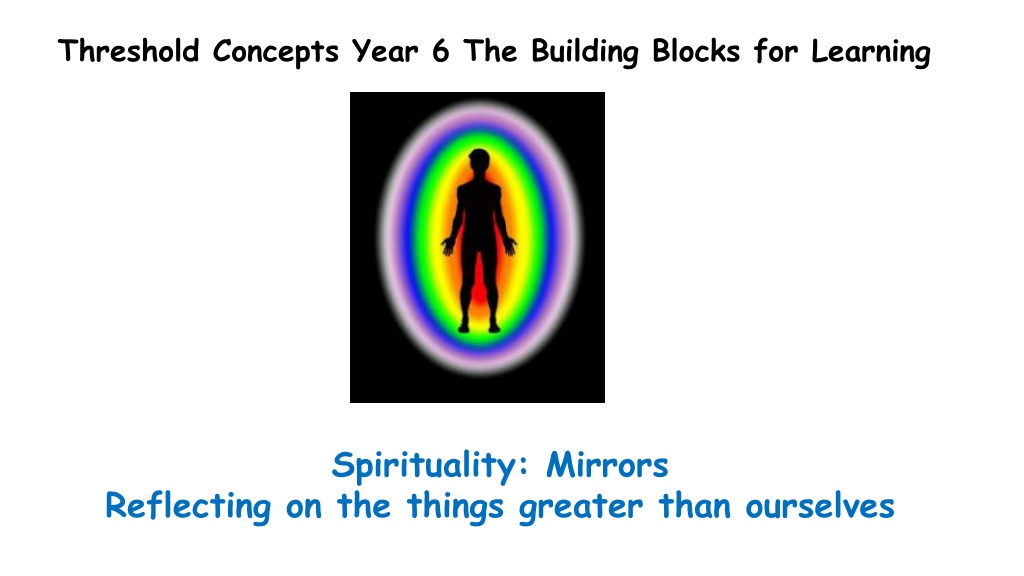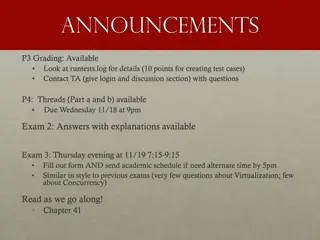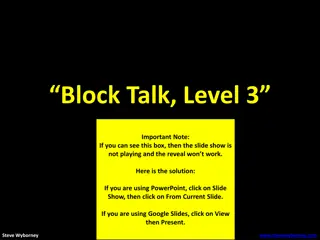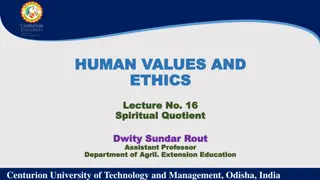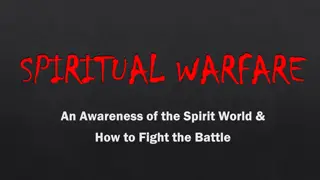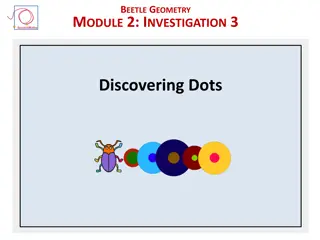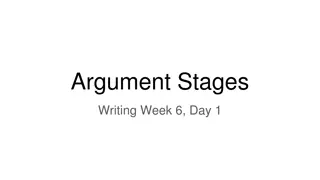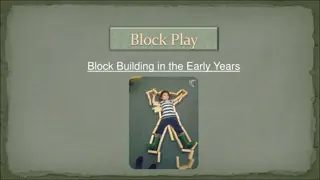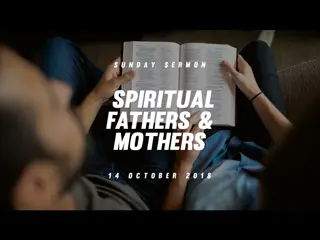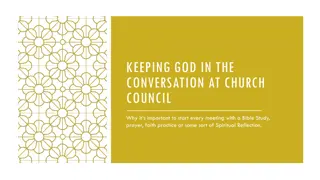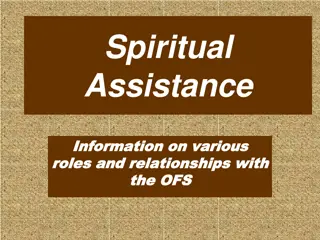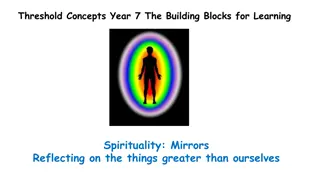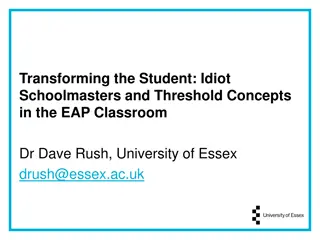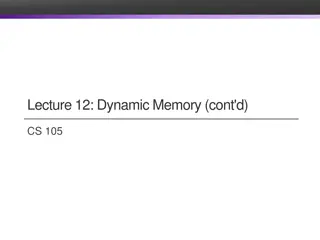Exploring English Threshold Concepts in Year 6: Building Blocks for Spiritual Learning
Delve into the comprehensive English threshold concepts for Year 6 students focusing on writing, reading, and speaking skills. Explore the magic of poetry and Greek myths as tools for spiritual growth and understanding. Develop a deeper connection with language through structured learning objectives and creative exploration.
Download Presentation

Please find below an Image/Link to download the presentation.
The content on the website is provided AS IS for your information and personal use only. It may not be sold, licensed, or shared on other websites without obtaining consent from the author. Download presentation by click this link. If you encounter any issues during the download, it is possible that the publisher has removed the file from their server.
E N D
Presentation Transcript
Threshold Concepts Year 6 The Building Blocks for Learning Spirituality: Mirrors Reflecting on the things greater than ourselves
English Threshold Concepts KS2 Writing Targets Write legibly Capital letters: I, proper nouns & sentences Full stops Question marks Join clauses using and Most sentences make sense Exclamation marks Subordinating and coordinating conjunctions Apostrophes for contracted words Commas (for lists) Paragraphs Inverted commas Correct use of tense Non-narrative: structure e.g. headings & subheadings Narrative: describe settings and characters Commas (fronted adverbials) Apostrophes for possession A range of cohesive devices: conjunctions, adverbials, pronouns & synonyms Select vocabulary: e.g. Show don t Tell in narratives; technical words in non-narrative Begin to match level of formality to audience Legible, cursive handwriting Semicolons, colons, hyphens, dashes, commas for clarity (relative clauses, parenthesis) Dialogue, Action, Description DAD (correctly punctuated) A range of sentence structures to match audience and purpose (incl. passive) Narrative: create atmosphere The voice of an author Precise use of punctuation to enhance meaning Control the level of formality Non-narrative: effectively organise information and ideas Create an effect (e.g. tension) 1 English Threshold Concepts Speaking Speak clearly and confidently Communicate effectively with vocal and body language 2 Reading 3 Read for pleasure Read fluently Extract ideas and information from a text Identify the meaning of words in context Make inferences supported by evidence Understand writers techniques and viewpoints Understand the audience and purpose of writing 4 5 Writing Use neat, cursive script to present with pride Use a range of punctuation to support meaning Use a range of sentence and text structures to support meaning Spell correctly to communicate clearly Use ambitious vocabulary Use subject vocabulary 6 Greater Depth
Magic Box: English Threshold Concepts Spirituality: Can poetry help us to create a connection with others and give us a sense of belonging? Poetry Reading Read fluently Identify the meaning of words in context Extract ideas and information from the text Understand writers techniques and viewpoints Identify writers techniques - Poetry Senses: Touch, Smell, Taste, Sight, Hearing Figurative language: Alliteration, Onomatopoeia, Repetition, Metaphor Structure: Verse Punctuation Further Vocabulary summary, imagery, expanded noun phrase, noun, determiner, adjective, preposition, phrase, main idea, annotate Challenge: Whilst reading, can you find a connection with the characters you find out about?
Greek Myths: English Threshold Concepts Spirituality: Can Greek myths help us understand the experience of living, flourishing and finding hope? Non-chronological report Reading Read fluently Identify the meaning of words in context Extract ideas and information from a text Can I identify writers techniques? Non-chronological report Headings and sub-headings Introduction Sections Introductory sentences for each paragraph Tables, pictures, diagrams, maps etc Technical vocabulary Formal or informal? Further Vocabulary context, synonym, sequence, main idea, summary, phrase Challenge: Read Greek Myths. Explore the messages they give.
Percy Jackson and the Lightning Thief: English Threshold Concepts Spirituality: Can stories help us find meaning and purpose in the things we value? Narrative-Suspense Reading Read fluently Identify the meaning of words in context Understand writers techniques and viewpoints Can I identify writers techniques? Suspense Senses: see, hear, touch, smell, taste Short sentences Ellipses Words which show fear, uncertainty, shadows, something hidden, death Simile, metaphor Further Vocabulary suggest, impression, according to the text, evidence, feeling, atmosphere Challenge: Read Percy Jackson and the Lightning Thief. What does Percy learn about himself from his adventures?
Christmas Carol: English Threshold Concepts Spirituality: Can self reflection bring positive change? Narrative Text Reading Read with fluency Identify the meaning of words in context Make inferences supported by evidence Identify writers techniques and viewpoints Identify writers techniques Self reflection Create atmosphere using the senses Long sentences Ellipses Vocabulary of emotion Simile, alliteration, onomatopoeia, metaphor Further Vocabulary impression, suggest, feeling, positive, negative, atmosphere, evidence Challenge: Read A Christmas Carol. Explore how Scrooge changes from the start to the end of the story.
Magnificent Machines: English Threshold Concepts Spirituality: Can human inventions create a sense of awe and wonder? Explanation Text Reading Read with fluency Identify the meaning of words in context Extract information and ideas from a text Identify writers techniques and viewpoints Identify writers techniques Explanation Texts Clear title Cohesive Devices Relative clauses Rhetorical questions Diagrams Further Vocabulary Formal: no contracted words, persuasive language exaggeration Challenge: Read a book which has a magnificent machine. What makes it magnificent?
Narrative Poetry: English Threshold Concepts Spirituality: Can classic poetry help us to experience living, flourishing and finding hope amidst pain? Descriptive Writing Reading Read fluently Identify the meaning of words in context Extract information and ideas from a text Make inferences supported by evidence Understand writers techniques and viewpoints Identify writers techniques - Poetry Senses: Touch, Smell, Taste, Sight, Hearing Figurative language: Alliteration, Onomatopoeia, Repetition, Simile, Metaphor Structure: Verse, Rhyme, alternate, couplets Punctuation Further Vocabulary inference, context, feeling, impression, poetry/poem, verse, image/imagery, narrative Challenge: Read some more narrative poems. Explore the feelings of the characters.
SATS prep and Writers Workshop Spirituality: Can trying our best bring us inner freedom? Writing Targets Write legibly Capital letters: I, proper nouns & sentences Full stops Question marks Join clauses using and Most sentences make sense Exclamation marks Subordinating and coordinating conjunctions Apostrophes for contracted words Commas (for lists) Paragraphs Inverted commas Correct use of tense Non-narrative: structure e.g. headings & subheadings Narrative: describe settings and characters Commas (fronted adverbials) Apostrophes for possession A range of cohesive devices: conjunctions, adverbials, pronouns & synonyms Select vocabulary: e.g. Show don t Tell in narratives; technical words in non-narrative Begin to match level of formality to audience Legible, cursive handwriting Semicolons, colons, hyphens, dashes, commas for clarity (relative clauses, parenthesis) Dialogue, Action, Description DAD (correctly punctuated) A range of sentence structures to match audience and purpose (incl. passive) Narrative: create atmosphere The voice of an author Precise use of punctuation to enhance meaning Control the level of formality Non-narrative: effectively organise information and ideas Create an effect (e.g. tension) 1 2 English Threshold Concepts Speaking Speak clearly and confidently Communicate effectively with vocal and body language 3 4 Reading Read for pleasure Read fluently Extract ideas and information from a text Identify the meaning of words in context Make inferences supported by evidence Understand writers techniques and viewpoints Understand the audience and purpose of writing 5 6 Writing Use neat, cursive script to present with pride Use a range of punctuation to support meaning Use a range of sentence and text structures to support meaning Spell correctly to communicate clearly Use ambitious vocabulary Use subject vocabulary Greater Depth
Stormbreaker - Tension: English Threshold Concepts Spirituality: Can experiencing tension in stories help us prepare for difficult events? Narrative - Tension Reading Read fluently Identify the meaning of words in context Extract ideas and information from the text Understand writers techniques and viewpoints Identify writers techniques - Tension Senses: Touch, Smell, Taste, Sight, Hearing Figurative language: Alliteration, Onomatopoeia, Repetition, Metaphor Short sentences for effect Vocabulary choice to show tension Further Vocabulary Hooking the reader, subject, verb, object, passive verb form (voice) Challenge: Find further examples of tension, whilst reading Stormbreaker.
Stormbreaker Persuasive Writing English Threshold Concepts Spirituality: Can becoming aware of the motives of others give us peace of mind and inner freedom? Persuasive Writing Reading Read fluently Identify the meaning of words in context Extract ideas and information from a text Make inferences supported by evidence Understand writers techniques and viewpoints Identify writers techniques - Persuasion Facts Opinion Repetition Rhetorical questions Exaggeration Further Vocabulary Semicolon, colon, bullet points Challenge: Whilst reading Stormbreaker, can you spot examples of characters hiding their motives?
Stormbreaker Villains: English Threshold Concepts Spirituality: Can characters in fiction help us to understand relationships? Descriptive Writing Describe a person, place or thing Create an image in the reader s mind A range of senses Evoke an emotion e.g. dislike Reading Read fluently Identify the meaning of words in context Extract information and ideas from a text Make inferences supported by evidence Understand writers techniques and viewpoints Audience: Teenagers looking for adventure Purpose: To explore how a character interacts with their environment Identify writers techniques - Description Senses: Touch, Smell, Taste, Sight, Hearing Figurative language: Alliteration, Onomatopoeia, Repetition, Simile, Metaphor Expanded noun phrase Adjectives expanded noun phrases Adverbs Simile, alliteration and onomatopoeia Metaphor Further Vocabulary protagonist, antagonist, atmosphere, compare Challenge: Whilst reading Stormbreaker, further explore the role of the antagonist.
Progression steps build on prior learning Grammar Grammar/Punctuation Punctuation 1. SOS Sentences Capital letters, full stop 2. Apostrophes 3. Nouns 4. Determiners 5. Verbs 6. Simple Tense 7. Pronouns 8. Commas 9. Adjectives 10. Inverted Commas 11. Reported Speech 12. Relative Clauses 13. Prepositions 14. Expanded noun phrases 15. Simple Sentences/Main clause 16. Active Verb Form (Subject, Verb, Object) 17. Coordinating Conjunctions 18. Subordinating Conjunctions/ Subordinating Clause 19. Adverbs 20. Modal Verbs 21. Fronted Adverbials 22. Parenthesis 23. Progressive Tense 24. Semicolons 25. Colons 26. Hyphens 27. Passive verb form 28. Perfect Tense 29. Dashes 30. Perfect Progressive Tense Other: Subjunctive, Sentence Patterns, Question tags Grammar Punctuation & Spelling: English Threshold Concepts Teaching GPS Include daily practise: top tips, whiteboard retrieval practice, SMHW quizzes, learning bookmark and SATS-style tests. Steps to Success Step 1: Identify Step 2: Describe Step 3: Produce Step 4: Reason and Justify Step 5: Create use in your writing. Lists of sentences - each sentence using the threshold concept. Year 5 Year 6 Embed learning into reading/writing units for introduction and retrieval practice KS3: Repeat teaching to embed learning within schemes of learning as appropriate to text type and needs of students.
